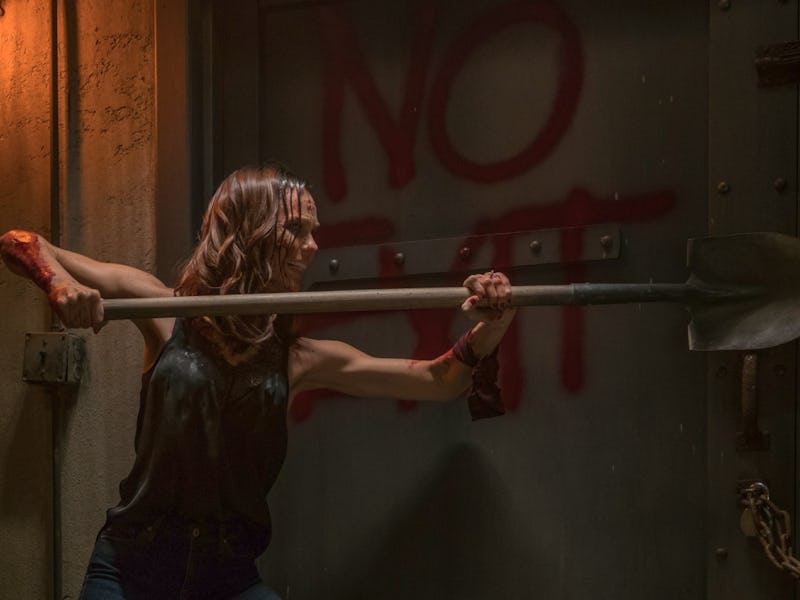The 'Jigsaw' Death Trap Designer Loves a Good Vegetable Slicer
"When we used our gore, it was for a reason"

The Jigsaw killer died ten years ago. So why have five unfortunate souls awoken to find themselves in the middle of an extensive obstacle course rigged with deadly traps? That’s the question that plagues police in Jigsaw, the eighth film in the Saw franchise and the first to make its way to theaters since 2007.
Jigsaw is a Saw movie for the next generation, focusing on high-tech gadgets to pull off the kills rather than anything more personal. The Jigsaw killer is just as storied in his fictional world as he is our own, so, of course, he’s got to adapt with the times. But is this Jigsaw, or someone else? Is it a copycat or an apprentice?
Jigsaw production designer Anthony Cowley — who also spent a season on the serial killer series Dexter as a production designer — gets to the bottom of how they made the eighth installment of a storied slasher franchise as vicious as the first. How do you freshen a classic slasher movie for 2017?
Inverse: It’s been a while since we’ve seen a new Saw movie.
Cowley: It is the eighth film, but it’s the first one they’ve done in six years, though after having done one every year for six years. They wanted to do it for a new audience. It’s more about high-tech, kind of generation Z-ish. So they hired a whole new creative team. They hired the Spierig brothers from Australia and then a cinematographer, also from Australia, named Ben Nott, and myself. And then we went to town from there.
Were you a fan of the Saw franchise before joining the Jigsaw team?
You wanna know something funny? I didn’t know what Saw was when they hired me for it. I had no idea. The reason that my directors wanted me was because I did the first three years of Dexter, and they love that TV show. And they said that’s the kind of intelligence they wanted. They wanted to use less gore and more of the mental background that Jigsaw uses — his psychological background. Less gore, and more payoff.
How did Dexter prepare you for Jigsaw, then?
If you think about it, the whole concept was based on the intelligence of his father, him saying, “Listen, we can’t get these guys because the system’s broken.” Then he raised his son to be that kind of guy, to punish people who had done wrong, right? So, if you think about it — and I didn’t realize it until I got the job — but the same concept applies to Saw. To me, it was such an easy leap.
What surprised you most about making a movie in the Saw franchise?
Well, since starting I know a lot more about Saw than I used to. [Laugh] One of the first things I did was watch a lot of Saw. Creatively, as far as the story and the film, it surprised me to the degree to which they thought out about the blueprints and what you can do in a trap. You couldn’t just create a trap; you create a trap, then there’s a reason why people are in the trap, but there’s always a way to get out of the trap if they make the right decision. But, of course, this is a Saw movie, so most of the time they don’t.
So, creatively that brought on a lot of challenges, both mechanically and for the visual effects of the traps. Because the producers and the writers, they will sometimes put in “Trap Here.” They don’t tell us what it is, they don’t tell us how it’s supposed to work. So that was left to Michael and Peter and myself and our wonderful producer Dan to come up with — Dan Hefner, who’s worked on every Saw since the first one — he was the first AD on the first Saw and now he’s the executive producer of this one.
It’s a very independent film. It’s run by the two producers who started it and Dan, the man who’s really the nuts and bolts of the whole movie. It’s not like there’s a million people with input and this has to be cleared through that. It’s kind of a nice position to be in because sometimes you’ve got decision by committee, which really kills you.
How did you guys come up with some of these traps?
It was just really nice to be able to come up with ideas and just riff off them. There’s one trap in there that I will tell you came out of a our heads out of a design for slicing vegetables in the kitchen. And then we took a story point that was given to us and made the mechanical driving force of that trap this vegetable slicer. To work under such great freedom of creativity, it was such a free experience, I really enjoyed it. I’m so anxious to do another one, so I’m hoping we get to do it next year.
Anything people should know in particular about Jigsaw?
I think what we tried to not make it inorganically gory but to make it — when we used our gore, it was for a reason. It was organic for why we did it. And when we did it, as you’ll see, there was no holding back.
Jigsaw premieres in theaters on October 27.